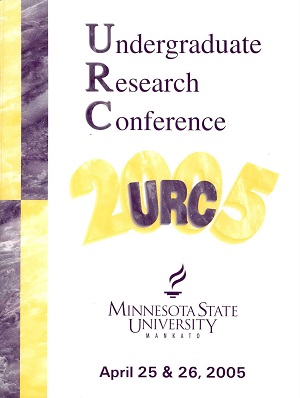Effects of Vitamin E Supplementation on 8- Hydroxydeoxyguanosine Concentration in Urine of Non-Fit Exercising Individuals
Location
CSU 253
Start Date
26-4-2005 10:00 AM
End Date
26-4-2005 12:00 PM
Student's Major
Biological Sciences
Student's College
Science, Engineering and Technology
Mentor's Name
Mary Hadley
Mentor's Department
Chemistry and Geology
Mentor's College
Science, Engineering and Technology
Second Mentor's Name
Mary Visser
Second Mentor's Department
Human Performance
Second Mentor's College
Allied Health and Nursing
Description
The concentration of oxygen is elevated in the body during exercise leading to increased levels of reactive oxygen species and thus, lipid peroxidation. This pilot study was designed to determine if athletes should be exceeding the adult recommended daily allowance, 15mg, of vitamin E intake to prevent damage due to increased levels of ROS (Reactive Oxygen Species). This pilot study helped gain knowledge of the effects of vitamin E supplementation on the urinary excretion of 8- hydroxydeoxyguanosine (8-OHdG) during times of physical fitness activity. 8-OHdG is a product of DNA molecules reacting with free oxygen radicals, and is a sign of oxidative damage. Vitamin E contains a hydroxyl group, which donates an electron to free radicals, preventing them from damaging the body. This experiment was used to determine if 8-hydroxydeoxyguanosine levels were decreased by vitamin E, providing cause for further experimental analysis. Subjects, half of whom consumed 400 lU of vitamin E daily, participated in a low level fitness program and kept twenty-four hour food intake records. Levels of 8-OHdG were quantified in the subjects urines by high performance liquid chromatography before and after the fitness program is complete. This pilot study should be completed again as a result of lack of participation. Too few subjects completed the required criteria to form a statistically meaningful conclusion.
Effects of Vitamin E Supplementation on 8- Hydroxydeoxyguanosine Concentration in Urine of Non-Fit Exercising Individuals
CSU 253
The concentration of oxygen is elevated in the body during exercise leading to increased levels of reactive oxygen species and thus, lipid peroxidation. This pilot study was designed to determine if athletes should be exceeding the adult recommended daily allowance, 15mg, of vitamin E intake to prevent damage due to increased levels of ROS (Reactive Oxygen Species). This pilot study helped gain knowledge of the effects of vitamin E supplementation on the urinary excretion of 8- hydroxydeoxyguanosine (8-OHdG) during times of physical fitness activity. 8-OHdG is a product of DNA molecules reacting with free oxygen radicals, and is a sign of oxidative damage. Vitamin E contains a hydroxyl group, which donates an electron to free radicals, preventing them from damaging the body. This experiment was used to determine if 8-hydroxydeoxyguanosine levels were decreased by vitamin E, providing cause for further experimental analysis. Subjects, half of whom consumed 400 lU of vitamin E daily, participated in a low level fitness program and kept twenty-four hour food intake records. Levels of 8-OHdG were quantified in the subjects urines by high performance liquid chromatography before and after the fitness program is complete. This pilot study should be completed again as a result of lack of participation. Too few subjects completed the required criteria to form a statistically meaningful conclusion.



